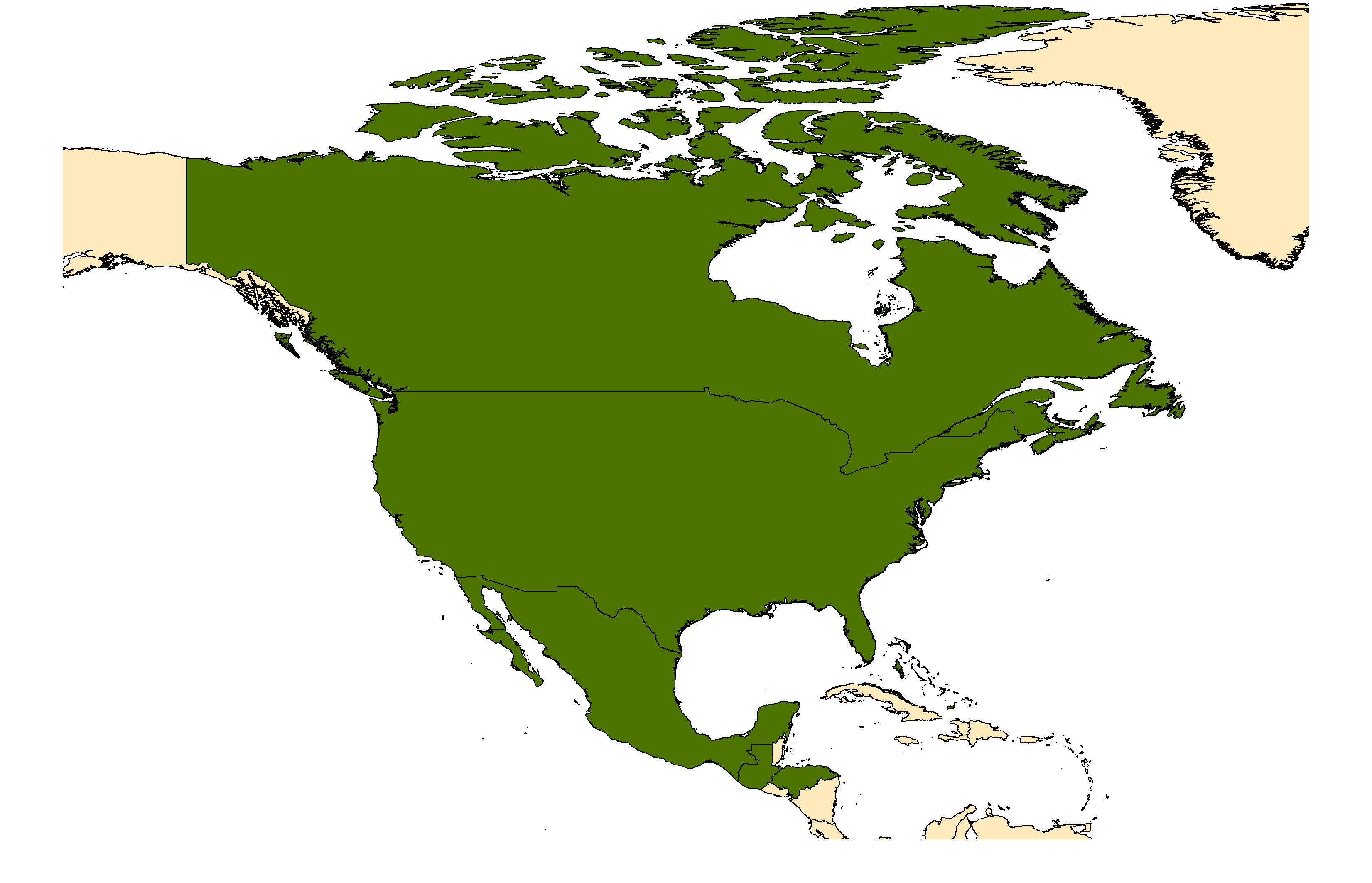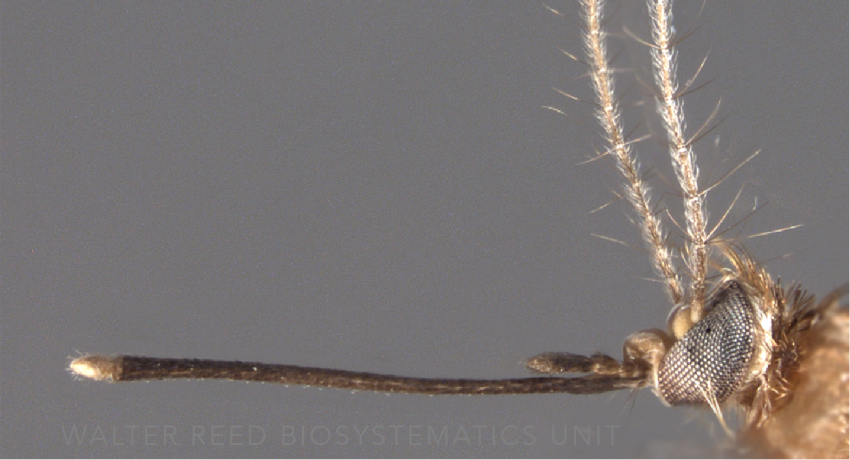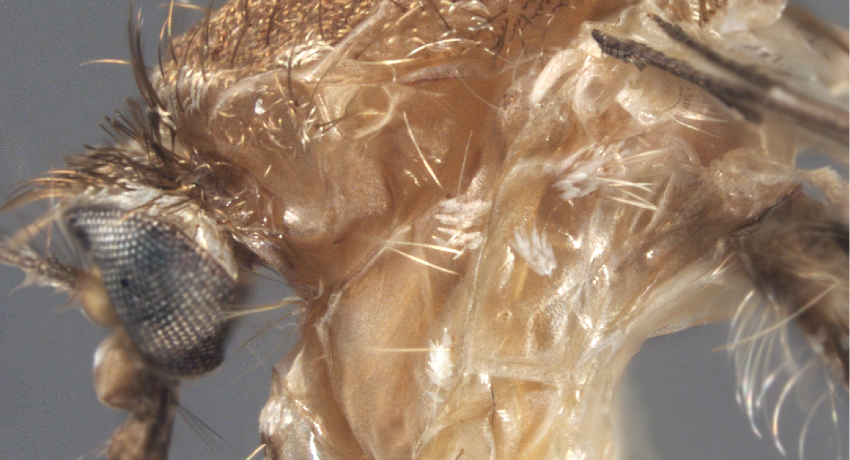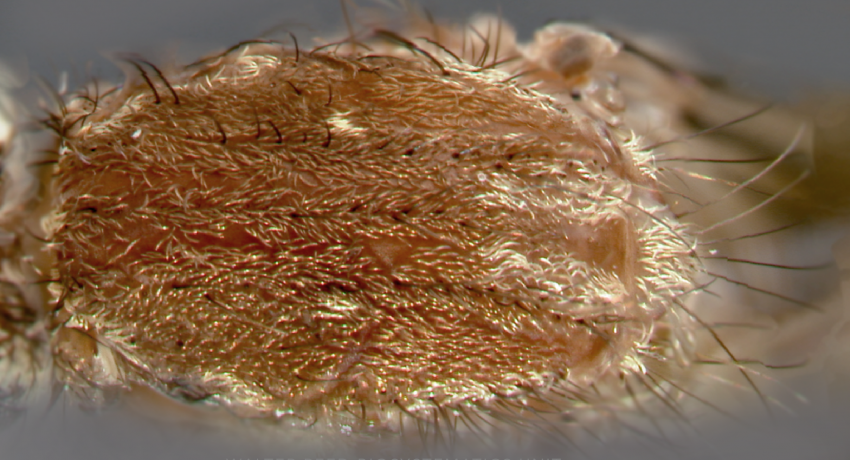NEARCTIC REGION
Etymology: not stated [see, look at, protect, watch? (L)]
Culex restuans is the nominotypical member of the Restuans Complex (Pipiens Group), together with Cx. acharistus Root, Cx. brethesi Dyar and Cx. laticlasper Galindo & Blanton. Culex restuans is often mistaken for Cx. pipiens Linnaeus or Cx. quinquefasciatus Say, which physically similar and occupy similar biological niches. The resultant misidentification and misleading biosurveillance reports based on mixed species pools, leading to incorrect associations of pathogens and bionomic traits. Some studies indicate that Cx. restuans may even be more common than Cx. pipiens in North America, and that misidentifications may over-estimate Cx. pipiens density. The range of Culex restuans stretches from Central America to Alaska.
Type locality: Toronto, Ontario, Canada
Type depository: Natural History Museum, London, England, United Kingdom (NHMUK)
DIAGNOSTIC CHARACTERS (Click photos to view; mouse over and click large photo to zoom in.)
ADULT (illustrated): Head: Proboscis entirely dark-scaled; vertex with narrow curved and erect forked scales on median and lateral areas, dark scales on occiput. Thorax: Scutum with acrostichal setae, fine dark brown scales and usually two small round white spots; scutellar midlobe with basal patch of white or cream-colored scales; pleuron with small patches of broad pale scales. Abdomen: Terga with distinct basal broad bands II–VII-Te. Legs: Ta-III1–5 dark-scaled.
LARVA (not illustrated): Head: Seta 1-A inserted 0.3–0.5 from base of antenna; seta 4-C usually 3,4-branched; seta 5–7-C with ≥3 branches, all with small aciculae. Thorax: Seta 3-P at least two-thirds of length of seta 1-P. Abdominal segments: Seta 6-I,II double, seta 6-III–VI long and single. Terminal segments: Pecten with 12–20 spines; siphon index 4.0–4.5; siphon without small spines near apex; siphon dorsally slightly convex basally and slightly concave apically; seta 2-X single, equal in length to 3-X.
TAXONOMIC KEYS
Carpenter & LaCasse 1955
Dodge 1966
Bohart & Washino 1978
Darsie & Ward 2005
Becker et al. 2010
Harrison et al. 2016
Exemplar DNA sequences
Culex restuans COI: JX259911–15, GU908085–GU908095
BIONOMICS
Immatures
Female Cx. restuans seek out shaded sites, under dense tree canopies for oviposition. Immatures occupy a variety of habitats, including ditches, stream pools, and artificial containers; females will lay more eggs in nutrient-rich waters than in clean water alone, and fewer eggs in habitats with existing conspecific larvae.
Adults
Culex restuans females primarily feed on birds, but will opportunistically feed on mammals, including people, and have been reported entering hoses to feed. Adult populations peak in spring and usually start declining by late summer. Culex restuans overwinters as adults in eastern United States.
DISTRIBUTION NOTES
Bahamas, Canada, Guatemala, Honduras, Mexico, United States (continental).

WRBU VECTOR HAZARD REPORTS
View other WRBU Vector Hazard Reports
Available GIS Models:
Cx_restuans_Dornak_1 North America
IMPORTANT REFERENCES (full citations below)
Theobald 1901c: 142 (F*)
Ross 1947: 47 (M*, F*, L*)
Darsie 1951: 33 (P*)
Yamaguti & LaCasse 1951c: 54 (M*, F*, L*)
Carpenter & LaCasse 1955: 288 (M*, F, L*; keys)
Bohart & Washino 1957: 463 (L*)
Dodge 1966: 370 (1st instar L*; key)
Bram 1967a: 94 (M*, F, L)
Belkin 1968b: 19 (type information)
Bohart & Washino 1978: 129 (M, F*, L*; keys, taxonomy, bionomics, distribution; California, United States)
Strickman & Darsie 1988: 21 (F*, L*; distribution; Guatemala)
Darsie & Ward 2005 (F*, L*; keys, distribution; United States)
Darsie & Day 2007 (P*)
Becker et al. 2010: 396 (F*, L*; key, taxonomy, distribution, bionomics)
Harrison et al. 2016 (F*, L*; keys, distribution; Mid-Atlantic United States
CURRENT SYNONYMS
syn. brehmei Knab
1916b: 161 (M, F, L). Type locality: [Newark], New Jersey, United States (USNM). References: Edwards 1932a: 207 (syn.); Stone & Knight 1957a: 45 (lectotype designation; type locality information).
CITED REFERENCES
Becker, N., Petrić, D., Zgomba, M., Boase, C., Madon, M., Dahl, C., & Kaiser, A. (2010). Mosquitoes and their control (Second ed.). Berlin Heidelberg: Springer-Verlag.
Belkin, J.N. (1968b). Mosquito studies (Diptera, Culicidae). IX. The type specimens of New World mosquitoes in European museums. Contributions of the American Entomological Institute, 3(4), 1–69.
Bohart, R.M. & Washino, R.K. (1978). Mosquitoes of California (3rd ed.). Berkeley, CA: University of California, Agriculture and Natural Resources.
Bohart, R.M., & Washino, R.K. (1957). Differentiation of second and third stage larvae of California Culex (Diptera: Culicidae). Annals of the Entomological Society of America, 50, 459–463.
Bram, R.A. (1967a). Classification of Culex subgenus Culex in the New World (Diptera: Culicidae). Proceedings of the United States National Museum, 120(3557), 1–122.
Carpenter, S.J., & LaCasse, W.J. (1955). Mosquitoes of North America (North of Mexico). Berkeley, Los Angeles: University of California Press.
Darsie, R.F., Jr. (1951). Pupae of the culicine mosquitoes of the northeastern United States (Diptera, Culicidae, Culicini). Ithaca, NY: Cornell University Agricultural Experiment Station Memoir 304.
Darsie, R.F., Jr., & Day, J.F. (2007). Redescription of the pupa of Culex restuans and a comparison with Culex nigripalpus. Journal of the American Mosquito Control Association, 23(2), 95–98.
Darsie, R.F., Jr., & Ward, R.A. (2005). Identification and geographical distribution of the mosquitoes of North America, north of Mexico. Gainesville, FL: University Press of Florida.
Dodge, H.R. (1966). Studies on mosquito larvae II. The first-stage larvae of North American Culicidae and of world Anophelinae. Canadian Entomologist, 98, 337–393.
Edwards, F.W. (1932a). Diptera family Culicidae. In P. Wytsman (Ed.), Genera insectorum (194th Fascicule) (pp. 1–258). Brussels, Belgium: Louis Desmet-Verteneuil.
Harrison, B.A., Byrd, B.D., Sither, C.B., & Whitt, P.B. (2016). The mosquitoes of the Mid-Atlantic Region: an identification guide (Vol. 1). Madison Heights, MI: Publishing XPress.
Knab, F. (1916b). A new mosquito from the Eastern United States. Proceedings of the Biological Society of Washington, 29, 161–163.
Ross, H.H. (1947). The mosquitoes of Illinois (Diptera, Culicidae). Bulletin of the Illinois Natural History Survey, 24(1), 1–96.
Stone, A., & Knight, K.L. (1957a). Type specimens of mosquitoes in the United States National Museum. IV: The genus Culex (Diptera, Culicidae). Journal of the Washington Academy of Sciences, 47(2), 42–59.
Strickman, D., & Darsie, R.F., Jr. (1988). The previously undetected presence of Culex restuans (Diptera: Culicidae) in Central America, with notes on identification. Mosquito Systematics, 20(1), 21–27.
Theobald, F.V. (1901c). A monograph of the Culicidae or mosquitoes (Vol. 2). London: British Museum (Natural History). with Atlas of 37 colored pls. + 5 pls. of photographs.
Yamaguti, S., & La Casse, W. J. (1951c). Mosquito fauna of North America. Part IV. Genera Culex and Deinocerites. Office of the Surgeon General, Headquarters, 8th Army, APO 343. United States. 207th Malaria Survey Detachment.
CITE THIS PAGE
Walter Reed Biosystematics Unit (Year). Culex restuans species page. Walter Reed Biosystematics Unit Website, http://wrbu.si.edu/vectorspecies/mosquitoes/restuans, accessed on [date (e.g. 03 February 2020) when you last viewed the site].











































































































































































